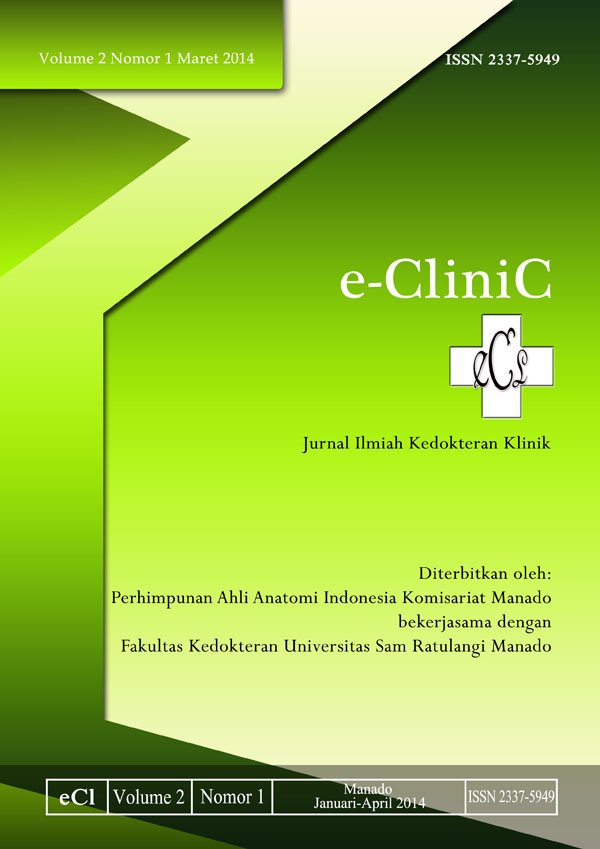HUBUNGAN PENGETAHUAN TERHADAP PERILAKU CUCI TANGAN PETUGAS KESEHATAN DI BAGIAN ILMU KESEHATAN ANAK BLU RSUP PROF DR RD KANDOU MANADO
DOI:
https://doi.org/10.35790/ecl.v2i1.3661Abstract
Abstract: Health care-associated infection (HCAI) is defined as an infection occurring in a patient in a hospital or other health care facility in whom the infection was not present or incubating at the time of admission. This incident result in excess length of stay, mortality and healthcare costs. World Health Organization (WHO) has been campaigning the patient safety program, one of it is to lower the risk of HCAI. Wash hands to be one of the effective measures to break the chain of transmission of infection. Doctors, nurses and other hospital personnel must work together to ensure that hand washing before and after each contact with the patient, whether the patient known to be infected or not. The aim of this research is to find out the relationship between knowledge and health workers’ hand washing behaviour in the department of child health at Prof dr RD Kandou Hospital Manado. This research was conducted using field survey design with observational analytic studies, in this case done by observation and questionnaires. The samples were 78. Conclusion: The result showed that from the 78 health workers there are 55 people who have poor knowledge about hand washing. As for health care workers with hand-washing behaviors are most numerous in the bad category amounted to 46 people. The results of the bivariate analysis showed the value of p = 0.160. From the result it can be concluded that there is no significant relationship between knowledge and behavior of hand washing in healthcare workers in the department of child health at Prof Dr RD Kandou Hospital Manado.
Keywords: Knowledge, Behavior, Hand Washing, Hand Hygiene.
Â
Â
Abstrak: Health care-associated infection (HCAI) didefinisikan sebagai infeksi yang terjadi pada pasien dalam rumah sakit atau fasilitas kesehatan lainnya dimana pada awalnya infeksi tersebut tidak hadir dan tanpa bukti inkubasi pada saat masuk rumah sakit. Kejadian ini menyebabkan lenght of stay (LOS), mortalitas, dan healthcare cost meningkat. World Health Organization (WHO) telah mengkampanyekan program keselamatan pasien salah satunya adalah menurunkan risiko HCAI. Cuci tangan menjadi salah satu langkah yang efektif untuk memutuskan rantai transmisi infeksi. Dokter, perawat dan personel lain rumah sakit harus bekerja sama untuk memastikan bahwa cuci tangan dilakukan sebelum dan sesudah setiap berkontak dengan penderita, apakah penderita diketahui terinfeksi atau tidak. Tujuan penelitian ini untuk mengetahui hubungan pengetahuan terhadap perilaku cuci tangan petugas kesehatan di Bagian Ilmu Kesehatan Anak BLU RSUP Prof Dr RD Kandou Manado. Penelitian ini dilakukan menggunakan desain survey lapangan dengan studi analitik observasional, dalam hal ini dilakukan dengan pengamatan dan pengisian kuesioner. Sampel berjumlah 78 orang. Simpulan: Dari hasil yang didapatkan dari 78 orang petugas kesehatan terdapat 55 orang yang memiliki pengetahuan kurang baik tentang cuci tangan. Sedangkan untuk petugas kesehatan dengan perilaku cuci tangan paling banyak terdapat dalam kategori buruk berjumlah 46 orang. Hasil analisis bivariat menunjukkan nilai p=0,160. Dari hasil penelitian ini dapat disimpulkan bahwa tidak adanya hubungan yang bermakna antara pengetahuan dan perilaku cuci tangan petugas kesehatan di Bagian Ilmu Kesehatan Anak BLU RSUP Prof. Dr. RD Kandou Manado.
Kata Kunci: Pengetahuan, Perilaku, Cuci Tangan, Kebersihan Tangan.
Downloads
How to Cite
Issue
Section
License
COPYRIGHT
Authors who publish with this journal agree to the following terms:
Authors hold their copyright and grant this journal the privilege of first publication, with the work simultaneously licensed under a Creative Commons Attribution License that permits others to impart the work with an acknowledgment of the work's origin and initial publication by this journal.
Authors can enter into separate or additional contractual arrangements for the non-exclusive distribution of the journal's published version of the work (for example, post it to an institutional repository or publish it in a book), with an acknowledgment of its underlying publication in this journal.
Authors are permitted and encouraged to post their work online (for example, in institutional repositories or on their website) as it can lead to productive exchanges, as well as earlier and greater citation of the published work (See The Effect of Open Access).







